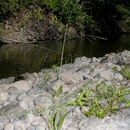Comments
provided by eFloras
Witch grass is a North American species that was apparently accidentally introduced to Pakistan and is now fully established as a weed of cultivated ground ground Ziarat. It belongs to that group of plants, along with Panicum turgidum, known as tumble-weeds. The whole inflorescence breaks off at maturity and is blown about by the wind, scattering its seeds as it goes. The plants in Pakistan belong to var. occidentale Rydb. in Contr. U.S. natn. Herb. 3:186. 1895 (Bor, Grasses Burma Ceyl. Ind. Pak. 332. 1960) differing from the type by their larger spikelets.
- license
- cc-by-nc-sa-3.0
- copyright
- Missouri Botanical Garden, 4344 Shaw Boulevard, St. Louis, MO, 63110 USA
Description
provided by eFloras
Tufted, densely hispid annual (rarely almost glabrous); culms 20-80 cm high, erect or ascending. Leaf-blades linear to narrowly lanceolate, 7-30 cm long, 5-14 mm wide, flat, sharply pointed. Panicle broadly ovate or broadly oblong, 15-50 cm long, the branches filiform, bearing spikelets on long capillary pedicels, the whole inflorescence eventually disarticulating. Spikelets elliptic or oblong, 1.8-2.5(3.3) mm long, glabrous, acute or acuminate; lower glume broadly ovate, membranous, a third to half the length of the spikelet, 3-nerved, obtuse, acute or slightly acuminate; upper glume 5-7-nerved; lower lemma 5-7-nerved, its palea about half as long; upper lemma pallid or yellowish to olive-brown, smooth and shining.
- license
- cc-by-nc-sa-3.0
- copyright
- Missouri Botanical Garden, 4344 Shaw Boulevard, St. Louis, MO, 63110 USA
Distribution
provided by eFloras
Distribution: Pakistan (Baluchistan; naturalised); North America.
- license
- cc-by-nc-sa-3.0
- copyright
- Missouri Botanical Garden, 4344 Shaw Boulevard, St. Louis, MO, 63110 USA
Comprehensive Description
provided by North American Flora
Panicum capillare L. Sp. PI. 58. 1753
Milium capillare Moench, Meth. 203. 1794.
Panicum Bobarti Lam. Encyc. 4: 748. 1797.
Panicum capillare agreste Gatt. Tenn. Fl. 94. 1887.
Panicum capillare vulgare Scribn. Bull. Tenn. Exp. Sta. 7: 44. 1894.
Chasea capillaris Nieuwl. Am. Midi. Nat. 2: 64. 1911.
Plants erect or ascending, simple or sparingly branched at the base or sometimes above, 20-80 cm. high; culms papillose-hispid to nearly glabrous, the pubescence dense at the nodes; leaf -sheaths usually longer than the internodes, densely papillose-hispid; blades 10-25 cm. long, 5-15 mm. wide, scarcely narrowed toward the rounded base, hispid on both surfaces, the midrib prominent; panicles densely flowered, large and very diffuse, often half the length of the entire plant, included at the base until maturity, the solitary or fascicled branches at first ascending, at maturity divaricately spreading, the whole panicle breaking away and rolling before the wind, the main axis and branches sparsely pilose, the numerous capillary, scabrous branchlets bearing long-pediceled spikelets toward their ends; spikelets 2-2.5 mm. long, 0.8-0.9 mm. wide, elliptic; first glume about half the length of the spikelet, acute, 5-7nerved; second glume and sterile lemma equal, more or less acuminate beyond the fruit, the palea of the sterile floret wanting; fruit about 1.5 mm. long, 0.7-0.8 mm. wide, elliptic.
Type locality: Virginia. . .
Distribution: Maine to Montana, and south to Florida and Texas; introduced in Bermuda.
- bibliographic citation
- George Valentine Nash. 1915. (POALES); POACEAE (pars). North American flora. vol 17(3). New York Botanical Garden, New York, NY
Physical Description
provided by USDA PLANTS text
Annuals, Terrestrial, not aquatic, Stems nodes swollen or brittle, Stems erect or ascending, Stems geniculate, decumbent, or lax, sometimes rooting at nodes, Stems caespitose, tufted, or clustered, Stems terete, round in cross section, or polygonal, Stems branching above base or distally at nodes, Stem nodes bearded or hairy, Plants conspicuously hairy, grayish, or wooly, Stem internodes hollow, Stems with inflorescence less than 1 m tall, Stems, culms, or scapes exceeding basal leaves, Leaves mostly cauline, Leaves conspicuously 2-ranked, distichous, Leaves sheathing at base, Leaf sheath mostly open, or loose, Leaf sheath hairy, hispid or prickly, Leaf sheath hairy at summit, throat, or collar, Leaf sheath and blade differentiated, Leaf blades linear, Leaf blades lanceolate, Leaf blades 2-10 mm wide, Leaf blades 1-2 cm wide, Leaf blades mostly flat, Leaf blades more or less hairy, Leaf blades scabrous, roughened, or wrinkled, Ligule present, Ligule a fringed, ciliate, or lobed membrane, Inflorescence terminal, Inflorescence an open panicle, openly paniculate, branches spreading, Inflorescence solitary, with 1 spike, fascicle, glomerule, head, or cluster per stem or culm, Inflorescence branches more than 10 to numerous, Flowers bisexual, Spikelets pedicellate, Spikelets dorsally compressed or terete, Spikelet less than 3 mm wide, Spikelets with 1 fertile floret, Spikelet s with 2 florets, Spikelet with 1 fertile floret and 1-2 sterile florets, Spikelets solitary at rachis nodes, Spikelets all alike and fertille, Spikelets bisexual, Spikelets disarticulating below the glumes, Rachilla or pedicel glabrous, Glumes present, empty bracts, Glumes 2 clearly present, Glumes distinctly unequal, Glumes equal to or longer than adjacent lemma, Glume equal to or longer than spikelet, Glumes 3 nerved, Glumes 4-7 nerved, Lemma similar in texture to glumes, Lemma 5-7 nerved, Lemma glabrous, Lemma apex acute or acuminate, Lemma awnless, Lemma margins inrolled, tightly covering palea and caryopsis, Lemma straight, Palea present, well developed, Palea about equal to lemma, Stamens 3, Styles 2-fid, deeply 2-branched, Stigmas 2, Fruit - caryopsis, Caryopsis ellipsoid, longitudinally grooved, hilum long-linear.

